Final Fantasy X
Square's first Final Fantasy for the PS2 is now available on Japanese shores. Find out more about the game's story and presentation in our in-depth preview.
Final Fantasy X is Square's PlayStation 2 follow-up to Final Fantasy VIII. That's eight, not nine--it seems that Square's brief flirtation with the old school began and ended with the ninth and final PS series game. Final Fantasy X, even more so than Final Fantasy VIII, challenges gamers' expectations of what a console RPG can be. Much of the staff--Director Yoshinori Kitase, Writer Kazushige Nojima, Art Director Yusuke Naora, and Character Designer Tetsuya Nomura--from the previous genre-defying title has returned for Square's first PS2 RPG venture. The latest installment of Square's flagship franchise has both feet planted firmly in the future--to quote another Final Fantasy game, "There ain't no gettin' offa this train we on!" Final Fantasy X makes no apologies for its changes to accepted genre conventions. 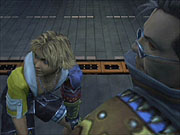
The changes are apparent from the opening sequence. A camera slowly pans over the party--with its weapons in a pile to one side--gathered around a campfire. Tidus, the main character, stands and walks away from the rest of the group. "This could be the end," he says, "so I want to tell you everything." The game then flashes back in time to the beginning of Tidus' adventure. This narrative device is used throughout the story; as the story unfolds for the player, the "future" Tidus will frequently interject comments about how he felt at the time or what this event meant to him in light of future understanding. This narrative device appears to be well implemented. 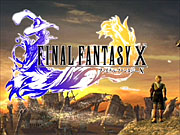
The main narrative itself, however, is compelling in its own right. The game begins with Tidus, world-famous athlete, signing autographs before a big blitzball game. On the way to the stadium, he sees a video screen of his father, Jecto, a famous former blitzball player. The game itself is an intense affair; blitzball is an extreme, zero-gravity sport played in a sphere of gravitationally suspended water. As the city watches the game, a giant sphere of energy called "Sin" moves toward the stadium. Sin is many things: an immense gravitational well, a tidal wave of floodwater, a streak of fireballs, and a source of strange, unseemly creatures. Regardless of the form that Sin takes, however, it is still a malignant and ineffable force. Unlike many antagonists of previous series, Sin is almost completely unknowable, like a force of nature. The quest to understand Sin's nature, origin, and purpose drives much of the early narrative. 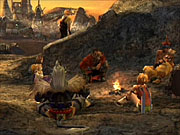
Sin destroys the blitzball stadium and the city of Zanarkand, wiping out most of the population. After a few close calls, Tidus manages to escape with the help of his mysterious friend, Auron. Before taking him into an unseen portal, the aloof Auron boldly proclaims, "Your fate is sealed--no one's but yours. This is your story!" Though this enigmatic comment is meant for Tidus, one can't help but feel he is addressing you, the player, as well. Final Fantasy X, like other series titles before it, puts you in the middle of an epic saga in which the fate of the world is in the balance. Through the portal, Tidus awakens in a strange, underwater world...
No hero ventures alone for long, of course, and Tidus soon meets friends and companions to help him on his way in this strange, new place. Tidus himself uses party-affecting abilities such as cheer, escape, and time-related spells (haste, slow). Other characters include the aforementioned Auron, a master swordsman who fights with special sword techniques. Auron is somewhat standoffish and knows far more than he is letting on. The first character that Tidus meets in the next world is Rikku, a thief and member of the Al Bhed tribe. Rikku uses traditional thief skills, like steal. 
The rest of the characters consist of summoner Yuna and her entourage. Yuna, daughter of Master Summoner Braska, is studying to become a summoner herself. Naturally, she can summon Aeons (summoned beasts) during battle. Yuna's group of guards includes Lulu, Kimahri Lonzo, and Wakka. Lulu, the sultry, fur-wearing member of Yuna's protectors, attacks with black magic. Her weapons are wind-up doll versions of previous Final Fantasy creatures; two of her first weapons are a moogle doll and a cactuar doll. Kimahri, a noble beastman, is the strong-but-silent type. A heavy hitter, he uses dragoon abilities, like jump, in battle. Wakka, a blitzball player for another team, is studying to become another one of Yuna's guards. He uses status attacks to disable the enemy. Summoners play a very important role in Final Fantasy X's world, and the rise of Sin makes them more susceptible to danger--and necessary. Yuna's father was world-famous for his deeds, and Yuna has an equally high profile--so her large number of bodyguards may not be entirely unwarranted. 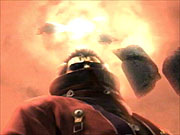
Final Fantasy X's battle system does away with the active time battle system that has been a series hallmark since Final Fantasy IV. In its place is a new, turn-based hybrid. Party members and enemies take turns entering individual commands, with the frequency of movement based on a character's agility. A comprehensive meter lets you see the order of execution for the next several turns. Informative, context-sensitive pop-up windows give you information about an enemy's HP, strengths, weaknesses, and immunities. In a significant change for the series, characters can be swapped in and out of battle at any time. More importantly, this swapping is "free" (that is, does not take a turn), so you'll find yourself frequently using several characters during a single encounter.
The return to a wait-oriented battle system, the ability to quickly switch party members in and out, and comprehensive information about upcoming turns and enemy status all lead to increased strategy and planning. Somewhat unsurprisingly, Final Fantasy X's battle director, Toshiro Tsuchida, previously worked on the Front Mission series. In practice, Final Fantasy X's battles plays like a strategy RPG with the location variable removed.
Summons are handled somewhat differently; when Yuna calls an Aeon, she stays on the screen while the other party members scatter. Once the Aeon has arrived, you control it like another party member would--you can make it attack, cast magic, and use special techniques. Aeons even have their own "overdrives," which are equivalent to the impressive summon effects of games past. Summons fight until they are released or until they die and can have their HP and MP refilled at inns, as well as save points. 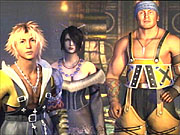
Each character also has an innate overdrive technique that can be used in battle. Tidus and Auron both use heavy physical strikes. Rikku uses alchemy to combine two potions or items to create a new item with a new effect. Kimahri can access blue magic, Lulu can cast multiple black magic spells, and Yuna can unleash a master summon. Overdrives have button presses and controller movements associated with each one, like Final Fantasy VI's and Final Fantasy VIII's Zell's limit breaks. During certain key battles, trigger attacks may become available. These context-sensitive abilities include a pincer attack, which immobilizes the enemy, or trying to talk to and reason with the enemy. 
Final Fantasy X handles character advancement in a dramatically different way from other RPGs. Instead of earning levels and experience in the traditional sense, progress is now made by moving character avatars on a giant game board called the sphere board. Fighting in battles earns AP to increase a character's sphere level, as well as consumable items such as power spheres, magic spheres, and speed spheres. Sphere levels are also consumable; each earned level equals a space that a character can move on the board. Each space on the board has a different effect, such as "increase MP by 40" or "increase speed by one." By using a consumable sphere on a space of that type, a character can permanently earn that particular ability. 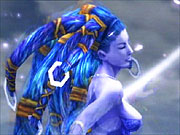
Though this sounds confusing, in practice, it works quite well. The sphere board looks confusing--it looks like a mass of very curvy lines, and you'll spend hours earning levels and traveling down a particular "path" before you reach a fork in the road. Second, intelligently placed sphere locks keep your characters from wandering too far off path too early. As you progress through the game, the locks gradually open, and your range of movement gradually increases. Finally, backtracking over previously covered territory is one-quarter the cost of moving forward, making late-game movement across the board more feasible. The sphere board system is one of Final Fantasy X's most nontraditional new "systems"; fortunately, it's fun, enjoyable, and seemingly well planned.
As in Final Fantasy VIII, weapons and armor take a backseat to innate ability statistics. In fact, weapons and armor in Final Fantasy X don't modify a character's statistics at all; the only differences appear to be the innate abilities they give a character for the duration of their use. However, there appears to be a way to modify these abilities and move them between equipment, and Square has said that later in the game, you will be able to add elemental alignments to your weapons and armor. Weapons and armor can be changed during battles and have almost no resale value, so you'll hang on to nearly everything for the game's duration. 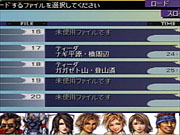
Graphically, Final Fantasy X is astounding and easily one of the best-looking games ever made. Games like Gran Turismo 3 are astounding in their replication of reality, but Final Fantasy X creates a new world with its own flavor and design. It is this freedom of creative expression, along with Square's mastery of the PlayStation 2's graphical hardware, that makes the game so constantly impressive. The opening sequence, for example, is filled with a visual creativity and energy notably absent from Square's recent Final Fantasy movie. The impossible, zero-gravity sport of blitzball and the otherworldly effects of Sin are startlingly rendered in exquisite detail. You will often feel like Tidus does in this new world, overwhelmed by unfamiliar sights. Fortunately, the other characters help Tidus (and you) make sense of the world. 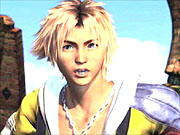
The biggest graphical change is in the background field maps; instead of prerendered backgrounds, the environments are now rendered in real time. Fortunately, the level of detail hasn't suffered any, and the constantly shifting camera makes them seem more dynamic than in previous games. The camera constantly follows you from a behind-the-shoulder perspective, as in the N64 Zelda games or in Sega's Skies of Arcadia. Another element similar to Skies of Arcadia is a helpful automap overlay, with your position and destination clearly marked. You can't control the camera, but the angles are so well chosen that they're hardly noticeable. The same location will frequently be rendered with different camera angles at different points in the narrative, helping to keep old locations fresh.
Story sequences are mostly done in-engine as well and are fantastic. The real-time nature means that previously impractical camera angles, close-ups, and quick-cuts can be used for cinematic effect. The motion capture is the smoothest yet, with nearly every story sequence using specially captured movements. Facial animation and lip-synching, though not perfect, are extremely well done for real-time effects. Battle graphics are similarly excellent; many encounters, in fact, take place directly on the field map, with battle menus simply appearing on top of the already visible characters and enemies. Even the FMV is uncommonly good, with astounding production values, flawless DVD quality video, and 5.1 Dolby Digital sound.
Even outside of FMV sequences, the sound has been significantly improved. Finally, the series has left its synthesized sound behind and joined the rest of the video game world in the post-16-bit era. Music is now of CD quality throughout. Series composer Nobuo Uematsu is joined for the first time by two other composers: Junya Nakano (Threads of Fate) and Masashi Hamauzu (Front Mission). The division of labor seems to have turned out nicely; as talented as Uematsu is, single-handedly writing more than a hundred songs is taking its compositional toll.
The other big aural change is the introduction of voice acting. After years of increasingly conspicuous absence, voice acting has come to the Final Fantasy series in a major way; every line by a party member or other main character is spoken. The only unvoiced dialogue appears to be with unnamed townsfolk. Square has announced plans to dub the game for its US release; given the large amount of voice acting and limited space on the DVD, it seems unlikely that the Japanese voices will be available as well. Still, Square's English voice work on the Bouncer was completely acceptable, and it seems unlikely it would drop the ball with its franchise title.
Like each Final Fantasy game since the eighth, Final Fantasy X has a "song." "Suteki da ne" is sung by Okinawan folk singer Rikki. The developers have tried to give the game an Okinawan feel throughout, from the design of the characters and Aeons to the graphics and music. Tidus, for example, means "sun" in an Okinawan dialect, while "Yuna" is a type of hibiscus flower. 
The first part of the game is extremely linear, like the Midgar sections of Final Fantasy VII, but it eventually opens up and provides you with much more freedom. Once the game opens up, many minigames and side quests become available. Playable minigames include a strategic, turn-based version of blitzball, as well as Chocobo racing. An extended side quest involves finding dictionaries to translate the Al Bhed dialect spoken by other members of Rikku's tribe.
Final Fantasy VIII and IX were two of the most divisive games of the PS era; though most RPG fans played both, most usually threw their lot in firmly with one game or the other. Final Fantasy X is squarely on the side of VIII; whether this is a good thing or a bad thing is up to personal discretion. Regardless of your feelings on the series' gameplay trajectory, there's no denying the game's artistic merits. Final Fantasy X will hit US shores in early 2002; the lengthy localization time is due to the large amount of voice acting, which will be redubbed in English. If Final Fantasy IX was a summary of everything the series had been, then Final Fantasy X is a first step into the series' future.
Got a news tip or want to contact us directly? Email news@gamespot.com
Join the conversation